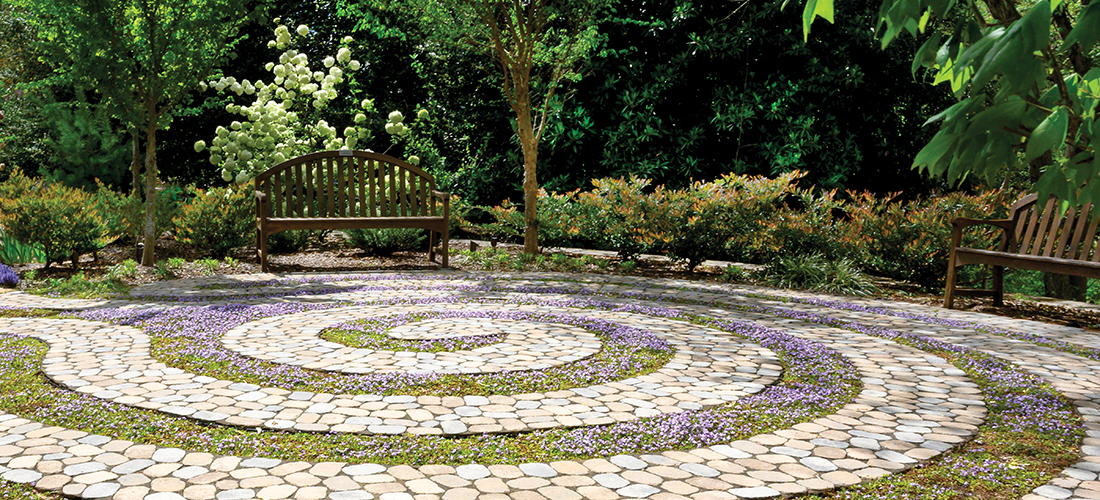
Thanks to a grand vision and several helping hands, Cone Health Cancer Center’s Healing Gardens offer space for transformation — within and without
By Ross Howell Jr.
Thursday morning in July — another workday for the Healing Gardeners, a band of volunteers providing care for a 2-acre sanctuary next to the Cone Health Cancer Center at Wesley Long Hospital.
The Healing Gardeners start early, tending to their assigned tasks before the heat becomes oppressive.
It’s a race with the sun.
I squint at the glaring concrete sidewalk as I make my way toward the hospital from the multilevel parking deck down the hill.
Ahead I spot a woman in a sun hat seated on a bench. She waves at me and stands. I glance to my left. Young oak trees rise just on the other side of the sidewalk’s aluminum handrails, and beyond I see raised walkways curving into an expanse of shrubs and trees.
At the bench I’m greeted by K. Porter Aichele. A petite woman with sandy blonde hair, she’s a retired professor from UNCG, where she taught art history and museum studies.
Not only does Aichele help with the care of the gardens, she also volunteers at the cancer center’s front desk.
“For a lot of patients, I’m the face of recovery,” Aichele says.
Is she ever.
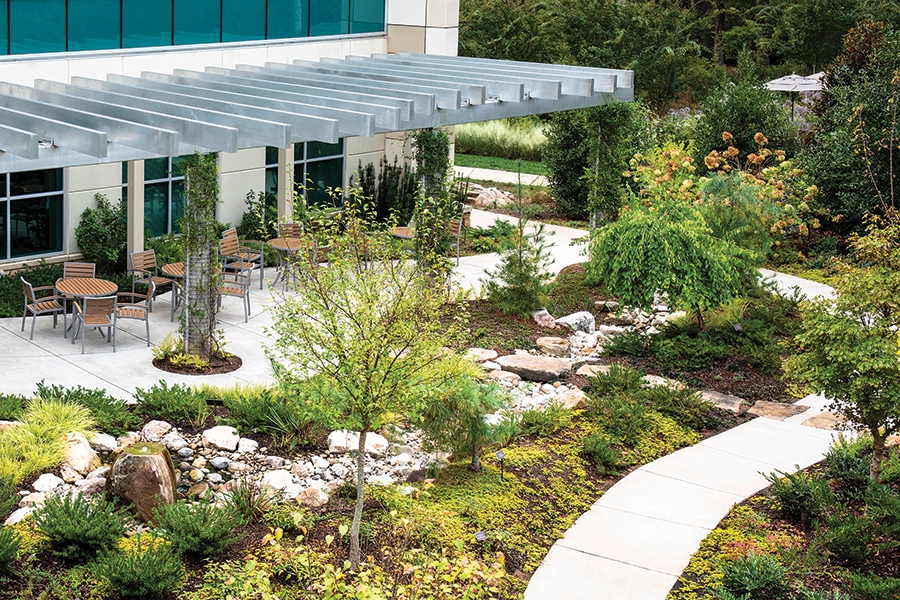
Aichele’s about 10 years out from being treated at the center herself — first, for breast cancer and later, for skin cancer.
“It was so depressing during my chemo,” Aichele says. “There was nowhere you could walk, unless it was among the cars.”
She gestures toward the garden.
“This was all riprap and poison ivy then,” Aichele says. She has a pleasantly deep voice and measures her words when she speaks. She gazes into the garden and nods.
“You know, Mary and I are both former patients,” Aichele continues, “so we know what this garden can mean to people.”
As if on cue, Mary Magrinat, head of the Healing Gardens, rounds the walk. She’s fair, with dark hair and pale blue eyes. There’s a quality in her face that’s radiant.
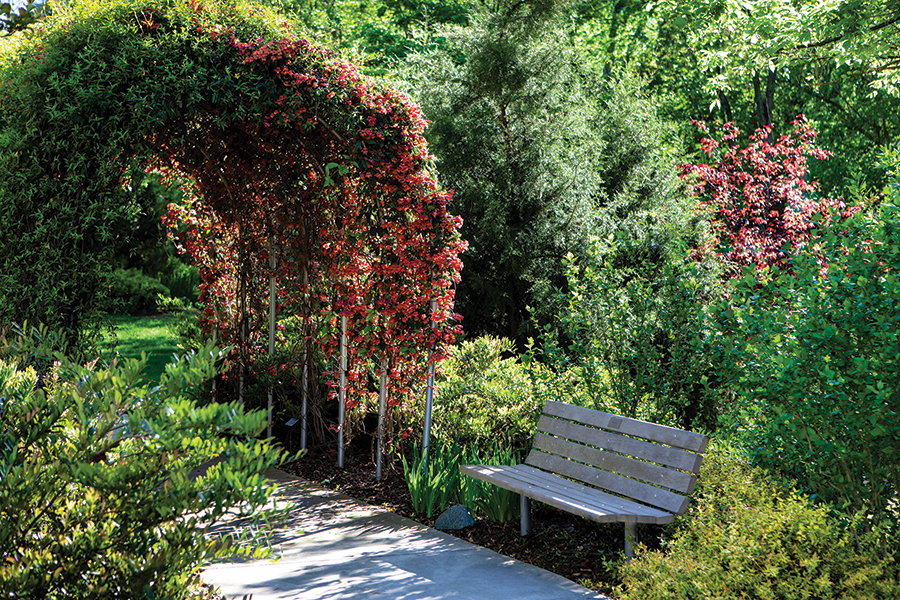
Magrinat’s a driving force behind the creation of the Healing Gardens. She seems to have been destined for it.
Half a lifetime ago, at age 36, Magrinat was diagnosed with an aggressive stage one form of breast cancer. Treatment saved her, and she was able to continue her professional career.
But not long after selling her financial services business, Magrinat and her husband, Gus, an oncologist with the Cone Health Cancer Center, were introduced to landscape designer Sally Pagliai, who had recently lost her husband, Stefano, to stomach cancer.
“You’ll be meeting her in a bit,” Magrinat says.
The boardwalk we start along is wide enough for a wheelchair. Magrinat tells me that we’re entering the Wetland Garden.
“Cone Health wanted to put a parking lot here or expand the cancer center,” Magrinat says, “but they determined that it’s absolutely not buildable.”

Protecting such a “biocell” is required by the North Carolina Department of Natural and Cultural Resources. In addition to providing food and shelter for wildlife, the wetland also filters impurities from drainage water before it flows into Buffalo Creek on the northern border of the garden.
That side of the garden is separated from Wendover Avenue by the creek and the north end of Lake Daniels Greenway.
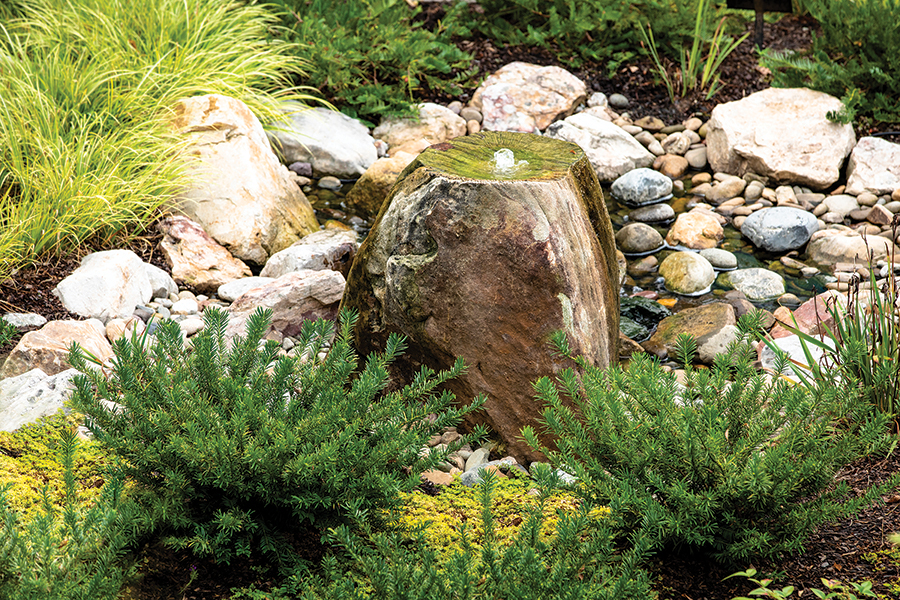
After Magrinat and others were successful raising private funds and lobbying for help from the City of Greensboro, a committee in 2013 had the space surveyed, cleaned up some debris and the Healing Gardeners undertook their first big project — planting 234 nondeciduous trees as a visual and sonic buffer between Buffalo Creek and Wendover Avenue.
Then Magrinat and others turned their attention to the wetland. With the construction of a nearby parking garage, drainage runoff into the area had become even more dramatic.
“In 2014–2015, we did a lot of planning and fundraising,” Magrinat says. Then the Healing Gardeners set to work in earnest.
Magrinat explains that everything I’m seeing — steps, walkways, benches, stonework, birdhouses, flowering plants, trees and shrubs — was paid for with private contributions.
“There was nothing here,” Margrinat says. Her smile brightens. “It’s completely transformed isn’t it?”
Yes, it is.
Magrinat describes the loop path we’re on. It goes all the way around the garden. If someone prefers a shortcut, there’s a boardwalk across the center. All the walks are wheelchair-accessible and enter the garden on the side that backs up to the hospital.
Vegetation abounds.
“Mostly we’ve tried to plant things that will thrive and take over,” Magrinat says, “but as you see, some cattails just showed up on their own.”
Trees planted by the Healing Gardeners include native river birch (Betula nigra), bald cypress (Taxodium distichum), sweet bay magnolia (Magnolia virginiana), tupelo (Nyssa sylvatica), red maple (Acer rubrum) and a variety of wax myrtles and cedars.
“We’ve done a lot of tree planting,” Magrinat continues. “We planted 353 trees within this garden in addition to the 234 along Wendover.”
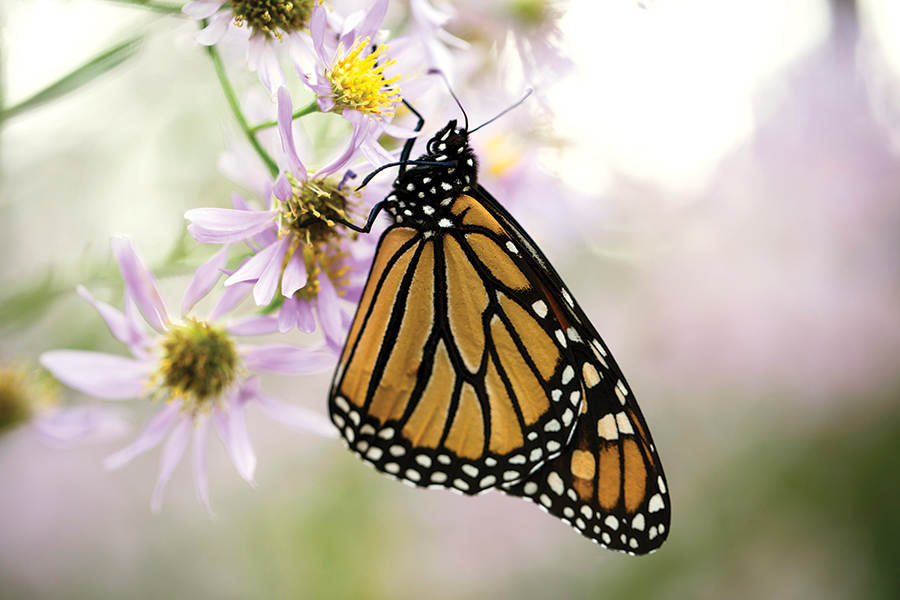
Among the native shrubs planted by the Healing Gardeners are yaupon holly (Ilex vomitoria), red buckeye (Aesculus pavia) and bottlebrush buckeye (Aesculus parviflora) — important food sources for wildlife. Wetland flowering plants include buttonbush (Cephalanthus occidentalis), marsh hibiscus (Hibiscus moscheutos) and swamp sunflower (Helianthus angustifolius).
With her usual command of numbers, Magrinat notes, “And we’ve planted more than one thousand ferns,” not to mention the scores of hellebores and hostas I’ve seen during our walk.
“The hostas are from Porter’s garden,” Magrinat says.
“I wish my Solomon’s seal looked a little better,” says Aichele. “And I have to tell the story behind the hellebores.”
Aichele tells me that they were a gift from the original garden of the late Dr. Jean Brooks.
“It’s a wonderful story,” Magrinat adds, “because she was the first female gynecologist in Greensboro.”
“It couldn’t have been a colder day in February when we moved the plants,” Aichele continues. “Every single one of these hellebores we brought over and planted here that day.”
Along the boardwalks, wooden benches invite quiet meditation, as do smooth boulders. When I comment on one of the stones, Magrinat and Aichele decide to show me the source of much of the Wetland Garden’s moisture.
We walk to the towering parking deck. Just visible behind boulders skillfully placed to obscure them are the enormous concrete culverts that drain the foundations of the deck. More stones are placed along the stream flowing from the culverts into the garden, naturalizing its appearance.
“This was one of the ugliest places in the garden,” Magrinat says. “Sally Pagliai and I had 65 tons of boulders brought in.
“Sally laid them out here and throughout the garden,” she continues.
“There were guys with forklifts setting the boulders,” Aichele adds. “Now they look like they’ve always been here.”
We approach a grassy spot with chairs alongside Buffalo Creek. Brightly colored ceramic butterflies are mounted on black metal posts at the edge of the grass.
“This is the one place where we added a little bit of color,” Magrinat says. “For the most part, nature is the star here and provides all the color, texture and sound.”
“Oh, there’s one of our gardeners,” Aichele says, pointing out a man on his knees in what looks to be a soupy patch of wetland. He waves happily and continues with his weeding.
We pass lovely white hydrangea bushes and a patch of joe-pye weed.
“We love those kaleidoscope abelias,” Aichele says, pointing them out. “They have such wonderful color.”
We pass a curved arbor. Though its springtime blooms are gone, Mary tells me the arbor is planted with trumpet vine on one side and Carolina jasmine on the other. There’s more sunlight in this part of the garden.
“I want you to meet Richard Mansell,” Magrinat says.
At age 84, Mansell is the senior Healing Gardener. He lived in Florida for 50 years and is a retired botany professor. A lanky, genial man, Mansell takes care of the succulent garden, the newest addition to the Healing Gardens.
Pagliai designed the rock garden that’s home to 75 succulent varieties, each one provided from Mansell’s home garden.
He tells me that after he moved to Greensboro, he first tried to grow flowers.
“My hose never was long enough to water them,” he chuckles, “so I said this is crazy, I’m going to grow something that doesn’t need water and is cold hardy.”
His favorites are sedums — blooming succulents often used as ground covers — along with sempervivums — low-growing succulents with rosette shapes, popularly known as hen and chicks.
Mansell points out sedums with interesting modulations of color and sempervivums of varying rosette shapes and pigments.
When I ask him about some prickly pear cactus volunteers in my yard, he tells me all about how he saw some mules eating cactus in a Florida pasture. We have a good laugh.
Aichele intervenes, teasing Mansell about weeds she’d noticed among his sedums.
“Get back to work, Richard,” she says, and we move along.
Next, Aichele introduces me to Healing Gardener Gerry Alfano.
“Here’s our coordinator,” Aichele says. “She calls us to arms every Thursday.”
Alfano laughs.
“Mary’s very convincing,” Alfano says. After Magrinat spoke at her garden club, Alfano ran into her at a neighbor’s Christmas party.
“When Mary found out I loved gardens,” Alfano continues, “and had worked with volunteers, she got me corralled.”
She explains that Healing Gardeners have a wide range of experience. Some are self-taught but have been gardening for years. Some are Master Gardeners. And some volunteers are complete novices.
“Those who don’t have any experience get paired with a Master Gardener,” Magrinat interjects.
“It’s a great way to learn,” Alfano concludes. “We all share a great love of the garden.”
Now we’re standing near a grove of Japanese maples in the shade of the cancer center. I look up at a balcony that juts out from the second floor, where patients receive treatment and therapy. New earth lies in mounds by the building.
Nearby, in the Meditation Garden, a woman carefully weeds a bed of herbs by a stone fountain. Closer, a woman guides a wheelbarrow loaded with shrubs by a stone labyrinth. The labyrinth is an original feature the Healing Gardeners have embellished with new plantings.
I hear the rattling of garden tools and the murmur of voices from a shed not far away. Birdsong and the drone of cicadas fill the air.
Even in the shade, I can tell the sun is getting hotter.
A tall, fit woman with shoulder-length brunette hair tucked under a hat is digging with a long-handle shovel.
“Sally?” Magrinat calls.
Healing Gardener Pagliai, a native Californian, is the owner of Studio Pagliai Landscape and Garden Design. She’s built gardens as far away as Florence, Italy and Singapore. She noses her shovel in the earth.
We greet each other, and Pagliai introduces the young woman working alongside her.
“This is Ali Brown,” Pagliai says. “She started with us a long time ago and she’s our little hardworkin’ Healing Gardens angel.” Brown smiles shyly and falls back to her task.
Magrinat, Aichele and Pagliai begin to apologize for the appearance of this section of the garden. They explain a construction company’s equipment tore up the landscape during the balcony renovation.
“Much to my chagrin we had to dig up all these trees,” Pagliai says, indicating a group of Japanese maples. “First I said no, but Mary said, yes, we will.”
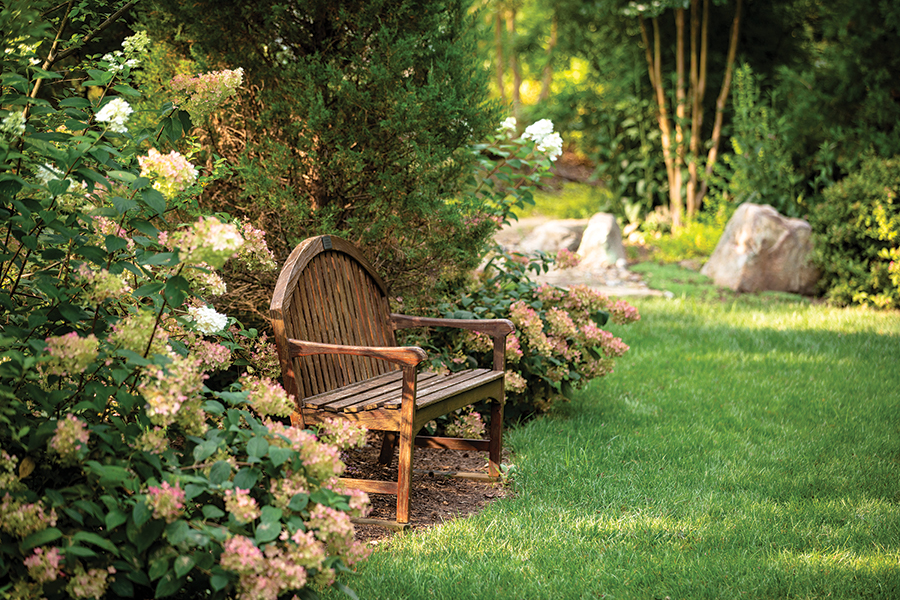
Magrinat takes up the story.
“The construction people said we’re going to cut these trees down and I said excuse me, you’re not cutting them down.”
“So we moved them under that tree and filled in with dirt,” Magrinat continues. “They were there for four months.”
“And they made it,” Pagliai smiles. “They made it.”
“We’re trying to start things back, but it’s messy,” Magrinat says.
“In another couple weeks, they’ll be beautiful,” Aichele assures her.
By the time I’m leaving, the sun is high in the sky as the Healing Gardeners continue with their tasks.
Some are people from the neighborhood. Others simply enjoy being outside, digging in the dirt. Some, like Magrinat and Aichele, are cancer survivors. Others, like Pagliai, have lost a loved one. Some just want to help.
In the end, aren’t we all in a race with the sun?
Sometimes I think about my own life. I wonder if I’ll leave anything beautiful or useful behind.
What a magnificent legacy will remain for every Healing Gardener working here today. OH
The Healing Gardens of the Cone Health Cancer Center at Wesley Long Hospital are open to the public year-round. The hours are dawn to dusk. And the Healing Gardeners can always use more hands, regardless of your garden knowledge or experience. To learn more about volunteering, email Gerry Alfano at mtisdel@att.net.
Ross Howell Jr. is a freelance writer. Contact him at
ross.howell1@gmail.com.





